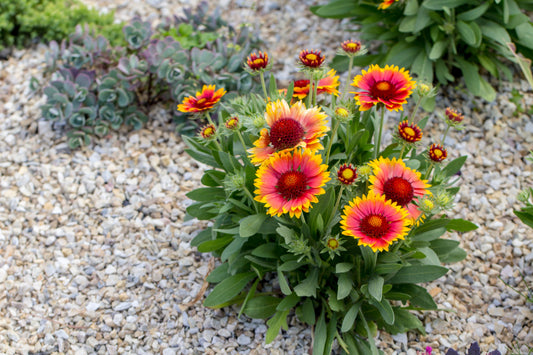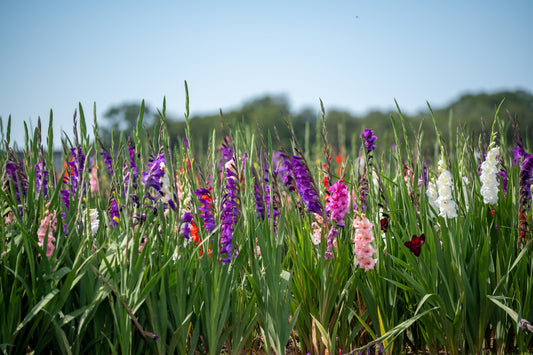Peony Planting & Growing Guide
Planting Guide Information
-
Plant Eyes 1-2" below soilPlanting Depth
-
2-3 ft ApartPlanting Proximity
-
Fall or SpringPlanting Season
-
Fragrant favorites in flower arrangements.Plant Benefits
-
ModerateWater Quantity
-
Late Spring to SummerBloom Season
-
Full to Partial SunSunlight Quantity
-
Zones 3-8Hardiness Zones
Additional Growing Information
Where to Plant Peonies
Peonies are long-lived and don't like being moved once planted. Peonies dazzle along walkways or as background plants for spring bulbs, and they pair beautifully with other plants in mixed borders. Position your Peonies where they will receive full sun to very light shade. While they can survive in moderate shade, they won't bloom as well and their stems will be weaker.
Peonies prefer to be consistently moist throughout the season without becoming waterlogged so choose a location with well-draining soil, which means that puddles following a hard rain should drain off within a few hours. If you need to improve your soil’s drainage, you can amend it with generous amounts of compost.
When to Plant Peonies
Plant your Peonies in the fall at least one month before the ground freezes, typically between late September and October. While Peonies can also be planted in early spring, fall planting allows for faster and more vigorous growth the following summer. (But a Peony planted in spring is better than a Peony not planted!) Should you have to move a mature Peony, be sure to do so in the fall when the plant has gone dormant and foliage has died back to the ground.
How to Plant Peonies
- Choose a spot where your Peonies will have plenty of room and space them at least 2–3 feet apart.
- Prepare the soil by digging out excess weeds and working in aged compost or leaf mold (chopped, composted leaves) throughout the top six inches of the planting area.
- Plant your Peony roots with the tips pointing downwards and the "eyes" or growing points 1/2" to 2" deep. In colder climates, plant on the deep end of this range; in warmer climates, plant them more shallowly.
- Backfill the hole, taking care that the root is no deeper than 2". Water generously, soaking the soil to eliminate air pockets around the root.
How to Grow Peonies
- Water your Peonies periodically during the growing season if you live in an arid climate or area experiencing a drought, particularly during heat waves. In temperate areas, deeper and less frequent watering will help the roots reach down for water.
- Stake Peony stalks to prevent them from breaking under the weight of their massive blooms.
- Sprinkle a light application of slow-release organic fertilizer around the root zone in spring to promote steady, vigorous growth.
- Cut Peony blooms to bring inside for cut-flower arrangements.
- Remove all spent flower heads and stems at the end of the blooming season. Your plant will continue to provide handsome foliage until the plant dies back to the ground in the fall.
Peony Tips & Tricks
- Foliage sprouts will appear in the spring, appearing as bright red or pink asparagus-like shoots. These sprouts will grow and change to green as they lengthen and develop leaves. Flower buds will eventually follow, but may not appear during the first spring after planting.
- During the first year, most roots will produce 2–5 leaf shoots and only 1–2 flowers. The plant size and number of flowers will continue to grow each year until the fourth or fifth year, when it will be full and bushy, with lots of foliage and many flower stems.
- Peonies develop massive root systems over time and prefer to grow in the same spot for years. Therefore, these plants are not the best choices for containers.
- Garden peonies appreciate cold weather during the winter and require at least 30 consecutive days of below-freezing temperatures to prepare to set blooms. The goal is to keep the roots cold, so freezing and thawing weather won't do the trick. Before purchasing a Peony, consider whether or not your environment supports this cold weather dormancy period. (They’re not the best choice for zones 8 and higher, but are champs for cold weather gardeners!)
From the Family
-
 35% Off
35% OffPeony - Double Flowering Mix
5 Peony RootsRegular price $38.97Sale price $38.97 Regular priceUnit price per$59.9535% Off -
 30% Off
30% OffPeony - Duchess de Nemours
1 Peony RootRegular price $13.97Sale price $13.97 Regular priceUnit price per$19.9530% Off -
Peony - Passionate Pink Collection
3 Peony RootsRegular price $29.99Sale price $29.99 Regular priceUnit price per$59.9550% Off -
 30% Off
30% OffPeony - Sorbet
1 Peony RootRegular price $13.97Sale price $13.97 Regular priceUnit price per$19.9530% Off -
 30% OffNew
30% OffNewPeony - Prairie Charm (Itoh)
1 Peony RootRegular price $27.97Sale price $27.97 Regular priceUnit price per$39.9530% OffNew








